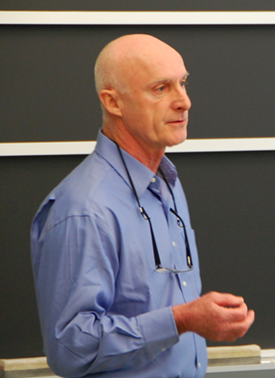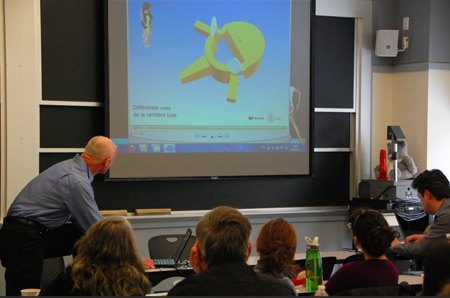Patrice Thiriet and Olivier Rastello presented their suite of 3D visualization tools for anatomy education on Wednesday, Jan 26. The tools were created at the University of Lyon1 in France, by a team including technologists, domain experts and visual artists who have compiled an open source suite available to all users. The interactive tools allow students to explore various aspects of human anatomy from perspectives that were hitherto impossible.
Using 3D Studio Max and other 3D software applications, Olivier Rastello and his colleagues have built a comprehensive suite of simulations for the human body. They can be experienced in three modalities:
 The 3 modalities can be used in tandem or selected separately according to the learning style of the student.
The 3 modalities can be used in tandem or selected separately according to the learning style of the student.
One of the remarkable capabilities of the interactive PDF modality is a ‘build’ feature that allows the user to select components to hide or reveal, thus permitting the relevant layers to emerge.
The Q&A session after Thiriet’s talk offered opportunities for MIT community members to further reflect and explore. One participant inquired about the use of formal evaluation techniques to measure the learning impact of the tools. Thiriet shared that evaluation studies indicate a definite and positive correlation between student use of the tools and improved test performance.
Thiriet also shared that students report enjoyment of the tool, gravitating towards it as an engaging environment.

It was also noted that the visualization tools have limits when adapted to suit various pedagogical needs. In Anatomy and Physiology, for example, the human body is so complex , choices must be made as to what elements to highlight and what others to obscure. Different instructors will make different choices in this regard, thus the 3d tools do not always accommodate all teaching goals and intents.
Another concern that Thiriet expressed was that tools such as this require a tremendous outlay of energy and research to develop. With technology changing so rapidly there is a risk of premature obsolescence.
OEIT's VIoleta Ivanova is working closely with Patrice, Olivier and their team to explore the use of Lyon 1's processes and technologies in support of 3d visual projects for education at MIT.
Please continue the conversation! Create an account, log in and share your thoughts and insights.